My Renovation Wake-Up Call
When I started my first big home renovation, I was confident, excited, and honestly… a little naïve. I thought I could upgrade my old kitchen, knock out a wall, and still stay within a tight budget. By week two, I was already over budget, facing unexpected electrical upgrades, and wondering where all my careful planning had gone.
That project taught me one big lesson: budgeting for a major home renovation is not just about the price tags you see upfront it’s about planning for the things you don’t see.
In this guide, I’ll walk you through how to budget properly, sharing real examples and tips so you can avoid the surprises I faced.
Understand Your True Renovation Goals
Before you start adding up numbers, take time to clarify what you want to achieve.
When I renovated, my initial goal was “a more modern kitchen,” but that was vague. As I dug deeper, I realized I wanted:
- More counter space
- Open sightlines to the living room
- Better lighting
Each goal added layers of cost knocking out a wall, installing recessed lights, rerouting electrical.
If your goal is to increase resale value, focus on upgrades that buyers care about (kitchens, bathrooms, energy efficiency). If your goal is personal enjoyment, prioritize what matters to your lifestyle (like a luxurious soaking tub or an open floor plan).
Break Down the Core Budget Categories
When you budget, divide costs into clear categories so you’re not blindsided.
Materials (40–50%)
Materials cover everything: flooring, countertops, fixtures, paint, tiles.
I saved $800 on cabinets by shopping at a local surplus warehouse instead of big-box stores. However, I splurged on quartz countertops because they were non-negotiable for me. Know where you can save and where you want to spend.
Labor (30–40%)
This includes contractors, electricians, plumbers, painters the people doing the hard work.
I got three quotes for my kitchen reno. One contractor quoted $20,000; another quoted $14,000 for similar work. By comparing, I saved $6,000.
Permits and Fees (5–10%)
Depending on your local rules, you might need permits for structural changes, plumbing, or electrical updates.
I forgot to budget for the $500 permit to remove a load-bearing wall. It delayed the project by two weeks while we waited for approval.
Contingency Fund (10–20%)
Always and I mean always set aside money for unexpected costs.
Mid-renovation, we found mold behind the drywall. Treating it cost an extra $2,500. Without our contingency fund, we would’ve been in trouble.
Get Multiple Bids and Compare Carefully
Even if you trust a contractor, get at least three bids.
For flooring installation, my first quote was $5,000. I got a second quote: $3,800. Same materials, similar timeline. Comparing saved me over $1,000.
Look at:
- Price breakdown
- Scope of work
- Estimated timeline
Don’t just choose the cheapest balance cost with reputation, reviews, and communication.
Prioritize: Must-Haves vs. Nice-to-Haves
List out everything you want then divide it into:
- Must-Haves (essential for safety, function, structure)
- Nice-to-Haves (upgrades, luxury finishes, non-essentials)
I wanted custom cabinet organizers, but they would’ve added $1,200. Instead, I got high-quality standard cabinets and added cheaper organizers later. That decision freed up funds to install under-cabinet lighting, which made a bigger impact.
Factor in Financing Options
Not everyone has cash ready for a big reno. You might explore:
- Home equity loans
- Personal loans
- Renovation-specific credit lines
I used a home improvement loan with a fixed rate and clear repayment plan. It helped spread costs over time without touching my emergency savings.
Track Every Expense
From big invoices to small purchases (like knobs or paintbrushes), track everything.
I kept a detailed spreadsheet with every cost. One month in, I realized we were overspending on delivery fees — small $30–$50 charges added up to nearly $600! Once I noticed, we consolidated orders to save money.
Prepare for Delays (and Budget for Them)
No renovation runs perfectly on schedule.
My countertop supplier had a two-week delay. That pushed back the backsplash installation, which pushed back painting. We ended up paying extra for temporary kitchen solutions (like a rental hot plate and microwave).
Build time and cost buffers into your plan so delays don’t wreck your budget.
Communicate Clearly with Your Contractor
Good communication can save you from costly misunderstandings.
I assumed our contractor would handle light fixture installation turns out, that was an extra $600. If we’d clarified the scope upfront, we could’ve budgeted or DIY’d it.
Final Thoughts: Budget Smart, Renovate Happy
Here’s what I learned the hard way: a successful renovation isn’t just about having a big budget it’s about planning well and staying adaptable.
Clarify your goals.
Break down and prioritize costs.
Build in buffers for surprises.
Track everything.
When you approach your renovation this way, you’re less likely to be caught off guard — and more likely to finish with a space you love, within a budget you can afford.




